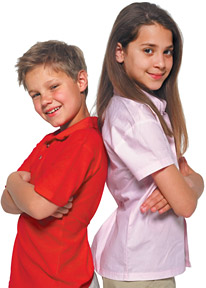Growing the Right Way With Chiropractic
By Kevin M. Wong, DC
A healthy spine is essential for good overall health. Like adults, a child's neck and spine need to be in proper alignment to facilitate good posture, movement and functionality. Understand the fundamentals of child spinal development and you'll quickly understand why your child can benefit from
chiropractic care.
As a chiropractor treating patients every day, I get asked a lot of questions. One of the most common questions posed to me is, "Why do children need to go to the chiropractor? They are so young. They don't need to be adjusted, do they?" The answer to this question is a resounding "Yes!" Let me take you on a journey of understanding so you can see why kids and chiropractic go hand in hand.
 I remember when 6-year-old Tucker (name has been changed for privacy) came in to see me for the first time as a patient. I had been treating his mother for over five years, and I had met him when he accompanied her on occasion. Tucker had been playing with one of his friends when he fell and hurt his neck. His neck was stiff and in so much spasm, he could not turn his head to the right. He was scared and his mother was concerned about whether he needed to go to the pediatrician.
I remember when 6-year-old Tucker (name has been changed for privacy) came in to see me for the first time as a patient. I had been treating his mother for over five years, and I had met him when he accompanied her on occasion. Tucker had been playing with one of his friends when he fell and hurt his neck. His neck was stiff and in so much spasm, he could not turn his head to the right. He was scared and his mother was concerned about whether he needed to go to the pediatrician.
After assessing his neck, I determined that his neck muscles were so tight that they had misaligned his neck vertebrae. I explained what was happening to him and then used very gentle methods to realign his spine. He was relieved to feel much better after we worked with him. The next day, he was almost back to normal.
Basics of Child Postural and Spinal Development
When babies are born, their bones are mostly cartilage, which is strong and flexible. Their muscles are underdeveloped, so they can't hold up their own head. Over the first few months of life, their muscles strengthen and they develop the ability to coordinate movement.
By three months of age, most babies can lift their head while lying on their stomach. At around six months of age, they can roll from their stomach onto their back, and by nine months they can sit unassisted. Babies then begin to crawl, and by their first birthday most are able to stand. As their spine and muscles develop - along with their confidence - they begin to walk.
When a baby is born, the spine is "C shaped." This changes at around the age of three months, when the curve in the neck develops and the baby gains control of head movement. The bones, ligaments, discs and muscles around the spine gradually become stronger and more coordinated, protecting the spinal cord and nerves within.
The curve in the baby's lower back develops as the baby starts to crawl, and is further developed as the baby begins to stand and walk. The C-shaped spine eventually changes into an "S shape" that will form the adult spine. This S shape gives the spine its flexibility and allows a greater range of movement, helping children's bodies to cope with the slips, jolts and falls that are part of growing up.
In most cases, the spine develops as a straight, upward structure. At times, there can be a side-to-side curvature called scoliosis. Scoliosis can vary from mild to severe. The more severe a scoliosis, the more likely internal organs and other structures can be stressed or compromised.
When we are born, our feet have no arches. As we go through our stages of development and begin to stand and then walk, the arches begin to form. We have three arches of the feet that eventually develop; they are fully formed by the time we reach 6-7 years old. Once a child has reached 7 years old, the feet are done developing and will grow accordingly with the rest of the body.

